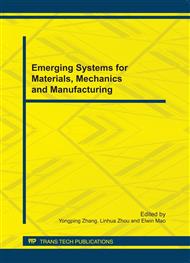p.84
p.91
p.96
p.100
p.105
p.110
p.114
p.120
p.125
Properties of Graphite Matrix Composite Bipolar Plate Reinforced by Short Carbon Fiber
Abstract:
Short carbon fiber is used to reinforce phenol formaldehyde (PF) resin/graphite composite. With carbon fiber by thick nitric acid liquid-phase oxidative surface treatment (TNALPOST) and its content 3.wt%~ 4.wt%, the composite flexural strength is increased highly and electrical conductivity is also increased on some degree. To PF resin/graphite matrix material without carbon fiber added, if PF resin content is 15.wt%, its flexural strength is 49.0MPa and electrical conductivity is 111S/cm. But with adding carbon fiber by TNALPOST and the same PF resin content , the composite flexural strength and electrical conductivity approach 68MPa、122S/cm respectively, both mechanical property and electrical property satisfy the requirement of USA Department of Energy on carbon filler/polymer composite bipolar plate. The PF resin/graphite composite without carbon fiber added presents brittle fracture mode, but with carbon fiber added, it presents ductile fracture mode. According to the fracture morphology by scanning electron microscopy, carbon fiber and matrix is on relatively weak boundary bonding state accompanied by fiber de-bounding、sliding、pulling-out and bridge-making to crack, they are main factors contributed to improving composite toughness.
Info:
Periodical:
Pages:
105-109
Citation:
Online since:
October 2011
Authors:
Price:
Сopyright:
© 2012 Trans Tech Publications Ltd. All Rights Reserved
Share:
Citation:


